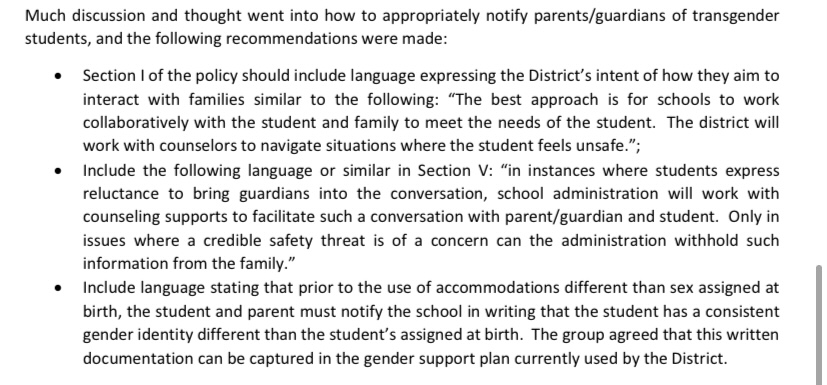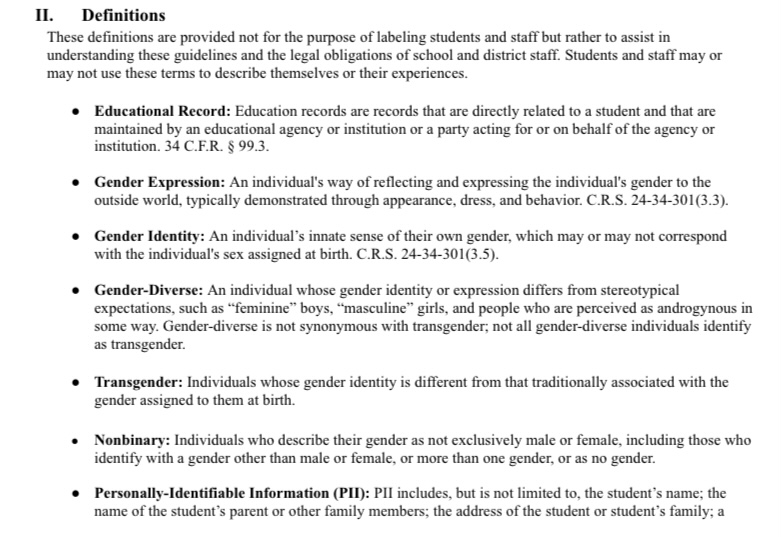A Colorado school district has agreed to stop concealing the transgender identity of students from parents unless it deems the child to be facing a “safety threat,” according to documents obtained by The Daily Signal.
The Cañon City School District hosted a Transgender Student Policy Work Group on Nov. 28, at which stakeholders decided schools can only withhold information about a child’s gender identity “where a credible safety threat is of a concern.” The district does not provide guidelines, however, for determining whether a threat is “credible.”
The best approach for notifying parents and guardians about their child’s transgender identity is to “work collaboratively with the student and family to meet the needs of the student,” according to a summary of the work group meeting shared on Wednesday with The Daily Signal.
The district will work with counselors if students are “reluctant” to notify their parents.
Following the work group’s meeting, the district posted an amended version of its previous transgender policies. The updated version includes increased parental involvement in a child’s gender transition process.

The original policies faced parental opposition in August for hiding student gender identity from parents, causing the school to table the policy until conducting the work group to “increase transparency and understanding and clarity regarding parental involvement, and other improvements to the policy.”
Ashley Mulso was one of several parents who spoke against the previous policy at an Aug. 8 school board meeting.
“Parents know the best care for their child,” she said. “When you have policies that say parental permission is not needed to transition or share locker rooms, you’re leaving parents with a tough choice, and they might have to pull their children out of the district.”
The new “Supporting Transgender and Gender-Diverse Students” standard operating procedure still does not require teachers to explicitly relay a student’s gender identity to the parents. The guide only prohibits the school from “actively” concealing gender identity.
“While the school will respect a student’s gender identity and expression and will honor a student’s preferred name and pronouns, it cannot actively conceal information from parents regarding a student’s decision to transition at school,” the guide reads.
Cañon City provides directions on how to handle the transitions of students in both elementary and secondary school. While parents of elementary students usually indicate the child’s “impending transition” to the school, school administration and staff will help secondary school students whose parents do not approve of their transition.
The school will ask transgender students what name and pronouns to use for them when contacting their parents. If a student’s gender identity is “different than the student’s assigned at birth,” the student and parent can use the district’s Gender Support Plan and Gender Communication Plan to notify the administration before the student can receive special accommodations, the work group decided.
If the parent refuses to use the gender communication and support plans, the school will continue to “support the student in their social transition within the school.”
“This discussion should include what the school and district can do to support the student’s safety at home, limits of confidentiality, working with the student to encourage parental involvement and providing the student with resources and support,” the guide continues.
The Gender Support Plan creates “shared understandings of how the student’s authentic gender will be accounted for and supported at school.” The form asks for the student’s preferred name, pronouns, and facilities, such as which restrooms and locker rooms the student will use and who the student will room with on overnight class trips.
“What are some ways that the student will respond to questions from any of the above (i.e., ‘Why is David using a new name?’, ‘Why is David using the girls’ bathroom now?’, etc.),” a question on the section of the form to be filled in by school staff reads.
The “Parent Involvement” section of the form asks for the student and staff member to indicate the child’s parent or guardian’s approval of their gender identity on a scale of 1 to 10.
“If support level is low, what considerations must be accounted for in implementing this plan?” the form asks.
“If the student’s guardians are not aware and/or supportive of the student’s gender status,” a question on the “Privacy” section of the form reads, “how will school-home communications be handled, including when individual staff members need to contact guardians?”
The form informs students of their “rights” to be called their “authentic name and pronoun,” use the locker room and restrooms corresponding with their preferred gender, attend school without harassment, and receive privacy.
The Gender Communication Plan form lays out blueprints for how students will share their gender identity with parents, classmates, other students’ parents, and school staff.
It asks for the student’s ideal method of sharing their gender identity, considerations for implementing the plan if parental support is low, and expectations for others, such as using the child’s new preferred name and pronouns and respecting the child’s new use of facilities.
The second page of the plan organizes training about the student’s gender for staff and parents of other students. The form also “identifies and enlists” parent and peer “allies.”
The work group decided to change the term “biological sex” to “sex assigned at birth” on the transgender student guide.
“Prior to the use of accommodations different from the sex assigned at birth, the student and parent may notify the school in writing that the student has a consistent gender identity different from the one assigned at birth and is requesting accommodations within the school setting,” the revised standard operating procedure reads.
The gender diversity guidelines define terms, including gender identity, “an individual’s innate sense of their own gender, which may or may not correspond with the individual’s sex assigned at birth”; transgender, “Individuals whose gender identity is different from that traditionally associated with the gender assigned to them at birth”; and non-binary, “Individuals who describe their gender as not exclusively male or female, including those who identify with a gender other than male or female, or more than one gender, or as no gender.”

A student’s “need” to transition can come to the attention of the school through a parent or the child, according to the guide.
“Any student may inform school staff of their strong desire to be consistently recognized at school using their stated gender identity, and this request should be acted upon respectfully,” the guide states.
The district instructs schools to “reduce or eliminate the practice of segregating students by gender.” The guide allows separate restrooms, locker rooms, and changing facilities insofar as students can use facilities “consistent with their gender identity.”
Students uncomfortable with the transgender accommodations can request a private restroom or changing room, but the school will “under no circumstances” require a transgender student to use a single-user facility.
Mulso, a Cañon City high school teacher and mother of three, said young students cannot be expected to advocate for a private room.
“Minors are not old enough to give consent to sharing a locker room or bathroom with someone of the opposite sex,” she said. “Parents need to be notified and parent permission must be required in these situations.”
The school will place transgender students in rooms for overnight activities “with the goals of maximizing the student’s social integration and equal opportunity.” Students who feel uncomfortable sleeping in a room with a classmate of the opposite biological sex can request a single room.
“Any alternative arrangement should be provided in a way that allows the student’s transgender status to be kept confidential,” the guide says.
The work group summary said the district would conduct a legal review of a proposal to create a religious exemption for staff and students uncomfortable with using preferred personal pronouns. The district and its legal counsel did not respond to questions about whether that has taken place.
Former Cañon City schools parent Tom Wenzl told The Daily Signal most Cañon City parents oppose the procedures.
“They feel like they are being discriminated against, or their students are, because the school is driven to grant access to locker rooms, sleeping spaces on overnight trips, and bathroom spaces with the overarching goal of trying to make the transgender student feel included,” Wenzl said.
“But when there is a person with the opposite biological body parts in the locker room,” he continued, “that discriminates against the rest of the student body that’s in that locker room, and they don’t feel like they’re being heard.”
The school district did not respond to The Daily Signal’s requests for comment by time of publication.
Have an opinion about this article? To sound off, please email letters@DailySignal.com and we’ll consider publishing your edited remarks in our regular “We Hear You” feature. Remember to include the url or headline of the article plus your name and town and/or state.
The post Colorado School District Revises Transgender Student Policy in Face of Parent Opposition appeared first on The Daily Signal.


0 Commentaires